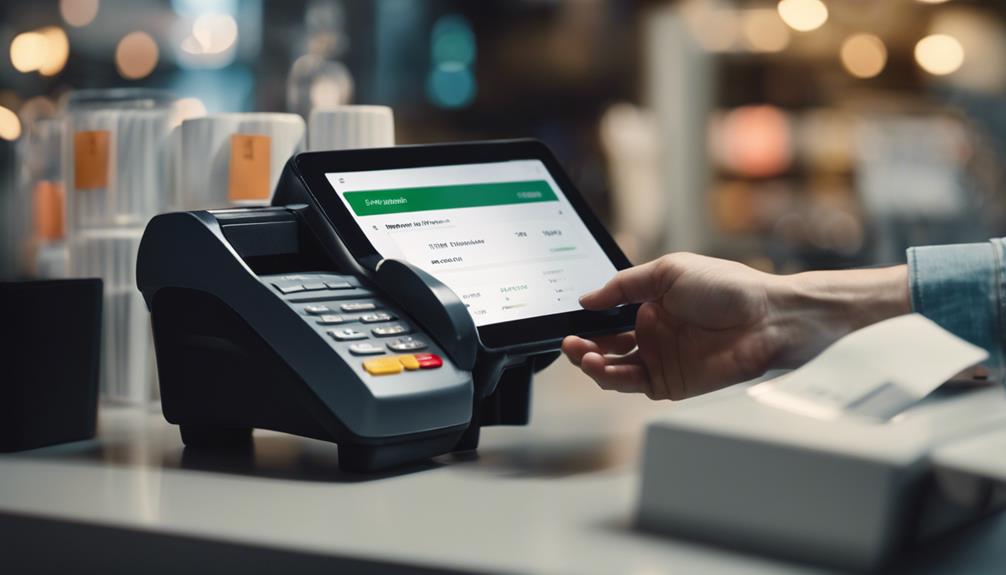Improve your small business efficiency by leveraging electronic payment systems to streamline transactions and enhance customer experience. Offer recurring payment options for convenience and guarantee quick, secure transactions. Specify clear due dates, penalties for delays, and flexible payment methods to minimize late payment hassles and optimize cash flow. Customize reminders based on past behavior, utilize various communication channels, and prompt action with clear deadlines and consequences. Efficiently manage accounts receivable with detailed invoices, follow-ups on overdue payments, and incentives for prompt payments. Software for tracking payments, encouraging electronic transactions, and providing payment flexibility saves time, reduces errors, and optimizes financial procedures.
Key Takeaways
- Utilize electronic payment systems for efficiency and speed.
- Offer recurring payment options to simplify transactions.
- Implement account receivable automation features for streamlined processes.
- Encourage prompt payments with penalties for delays.
- Provide flexible payment options to cater to diverse needs.
Enhancing Customer Experience With E-Payments

Enhance your customers' payment experience by utilizing the convenience and efficiency of electronic payment systems. By offering electronic payment options, you can streamline the payment process for your customers, making it easier and more convenient for them to settle their bills.
With the simple and effective design of e-payment systems, customers can make payments quickly and securely. Additionally, e-payment systems often come with recurring payment options, allowing customers to set up automatic payments for ongoing services. This not only saves time for your customers but also guarantees timely payments for your business.
Consider implementing account receivable automation features in your electronic payment system to further enhance the payment experience for your customers.
Minimizing Late Payments Hassles

To minimize the hassles of late payments, make sure you establish clear payment deadlines for your customers. Setting expectations upfront can help avoid misunderstandings and delays in receiving payments. Consider using the following strategies to streamline your payment process:
| Strategy | Description | Benefits |
|---|---|---|
| Clearly Defined Payment Deadlines | Specify exact due dates for invoices to guarantee timely payment | Reduce confusion and improve cash flow |
| Implement Late Payment Fees | Include penalties for delayed payments to incentivize customers to pay on time | Encourage prompt payments and deter delays |
| Offer Payment Plans | Provide flexible payment options for customers facing financial difficulties or cash flow issues | Maintain customer relationships while ensuring payments |
Maximizing Reminder Effectiveness

To improve your payment collection process and guarantee timely payments, focus on maximizing the effectiveness of your payment reminders.
- Customize reminders based on past payment behavior to increase relevance.
- Utilize multiple communication channels like email, text, and phone calls for reminders.
- Clearly state payment deadlines and consequences for late payments to prompt action.
Improving Payment Procedure Efficiency

Improving the efficiency of your payment procedures requires clear and streamlined processes for billing, late payments, credit approvals, and customer data maintenance. To enhance your small business payment procedures, consider the following strategies:
– Implementing digital invoicing and payment systems can help automate billing and reduce the risk of late payments. This can be achieved through platforms like Quickbooks payment processing, which allows for easy credit card and bank transfer payments. Additionally, regularly reviewing and updating customer data can improve credit approval processes and reduce the risk of fraud. By adopting these strategies, small businesses can improve their overall efficiency and cash flow. – Another strategy to enhance small business payment procedures is to offer a variety of payment options to customers, such as credit card, debit card, and online payment platforms. This can streamline the payment process for customers and encourage timely payments. Additionally, utilizing the reporting and analytics features of Quickbooks payment processing can provide valuable insights into payment trends and customer behavior, allowing for more informed decision-making. By leveraging these tools, small businesses can effectively manage their payment procedures and optimize their financial operations. – Lastly, incorporating automated payment reminders and follow-up procedures can help mitigate the impact of late payments. With Quickbooks payment processing, small businesses can set up automated reminders for overdue invoices, reducing the burden of manually monitoring and chasing unpaid bills. This can ultimately improve cash flow and minimize the negative effects of late payments on the business. By combining these strategies with the use of Quickbooks payment processing, small businesses can streamline their payment procedures and foster stronger customer relationships. Additionally, taking advantage of the integration capabilities of Quickbooks payment processing with other business software can further enhance efficiency and accuracy in financial management.
| Strategy | Description | Benefits |
|---|---|---|
| Implement Automation Tools | Utilize software for invoicing and payment tracking | Saves time and reduces errors |
| Require Online Payments | Encourage electronic payments for faster transactions | Improves cash flow and reduces delays |
| Offer Multiple Payment Options | Provide flexibility with various payment methods | Increases customer satisfaction |
Optimizing Accounts Receivable Management

Enhance your small business's financial efficiency by optimizing accounts receivable management through systematic processes and clear procedures.
- Implement Clear Invoicing: Guarantee invoices are detailed and easy to understand. Include clear payment terms, due dates, and accepted payment methods.
- Establish Follow-Up Procedures: Create a system for following up on overdue payments. Send reminders before and after the due date, and have a process in place for handling late payments.
- Offer Incentives for Early Payments: Encourage prompt payment by offering discounts or other incentives for clients who pay before the due date. This can help improve cash flow and reduce the number of late payments.
Frequently Asked Questions
How Can Small Businesses Encourage Customers to Opt for Recurring Payments?
To encourage customers to opt for recurring payments, offer incentives like discounts or exclusive deals for subscription-based services. Make the process user-friendly with clear instructions and easy setup.
Provide secure payment options and emphasize the convenience of automated payments. Remind customers of the benefits of recurring payments, such as saving time and ensuring timely transactions.
Build trust by highlighting the reliability and flexibility of your recurring payment system.
What Are the Best Practices for Implementing Late Payment Fees?
To implement late payment fees effectively, clearly outline payment terms in your policies. Set solid deadlines and send reminders before due dates. Consider offering payment plans for late clients and enforcing late fees consistently. Having organized procedures for billing, late payments, and credit approvals is essential.
Communicate expectations clearly to customers and build strong relationships to encourage timely payments. These steps can help streamline payments and boost efficiency in your small business operations. One effective way to facilitate timely payments is to utilize Quickbooks payment processing, which allows customers to easily and securely make payments online. By offering this convenient option, you can further encourage prompt payments and minimize the risk of late or missed payments. Additionally, utilizing Quickbooks payment processing can help to automate the invoicing and payment collection process, saving time and resources for your small business. Implementing Quickbooks payment processing solutions can also help improve transparency and accuracy in your financial records. By integrating with your accounting system, Quickbooks payment processing can provide real-time updates on payment status and streamline reconciliation processes. This level of visibility allows for better cash flow management and strategic decision-making to further optimize your business operations. Overall, utilizing Quickbooks payment processing solutions can enhance customer satisfaction, improve cash flow, and ultimately contribute to the long-term success of your small business. Furthermore, Quickbooks payment processing can also help to minimize payment errors and reduce the administrative burden of manual data entry. With the ability to set up recurring payments and automated reminders, you can ensure that payments are received on time and in the correct amount. This level of automation can help improve accuracy and reduce the risk of human error, ultimately saving time and resources for your small business. With Quickbooks payment processing, you can take advantage of robust reporting and analytics tools to gain insights into your payment trends and customer behavior, allowing you to make informed decisions to optimize your cash flow and financial strategies.
How Can Businesses Customize Payment Reminder Templates Effectively?
When customizing payment reminder templates, focus on clarity and professionalism. Include key details like invoice numbers, due dates, and payment amounts.
Personalize messages with customer names and account specifics. Use a friendly yet assertive tone to encourage prompt payments.
Guarantee templates are easy to read and understand, avoiding jargon or complex language. Consistency in branding and formatting across all reminders helps establish credibility and reinforces your brand image.
What Steps Can Be Taken to Streamline Credit Approval Procedures?
To streamline credit approval procedures effectively, start by establishing clear criteria for credit assessment. Utilize automated tools for quick credit evaluations and implement standardized processes for consistency.
Set up a dedicated team to handle credit approvals promptly, ensuring timely decisions. Regularly review and update credit policies to adapt to changing business needs.
How Do Electronic Payment Systems Help in Automating Accounts Receivable?
Electronic payment systems help automate accounts receivable by providing convenience for customers and streamlining payment processes. They offer options for recurring payments, automate reminders, and enhance organization in managing receivables.
With clear procedures and automated features, these systems reduce late payments and manual follow-ups. Efficient design and online accessibility contribute to long-term relevance and efficiency in managing accounts receivable.
Conclusion
To sum up, by incorporating e-payment systems, setting clear payment deadlines, and implementing effective reminder strategies, small businesses can streamline their payment processes, minimize late payment hassles, and optimize accounts receivable management. Additionally, small businesses can benefit from utilizing a quickbooks payment processing upgrade to further enhance their payment systems. By integrating this software, businesses can automate the payment process, track income and expenses, and generate detailed reports to analyze their financial performance. This can ultimately lead to improved cash flow and better financial decision-making for the business. In addition, by utilizing features such as invoice tracking and payment scheduling, small businesses can further streamline payment processes in quickbooks. This can help them stay organized and ensure that all payments are made and received in a timely manner. Overall, these strategies and tools can help small businesses effectively manage their finances and maintain healthy cash flow. Furthermore, by adopting faster payment processing methods such as electronic fund transfers and mobile payment options, small businesses can reduce the time it takes to receive payments from customers. This can help improve cash flow and provide greater financial flexibility for the business. By combining these strategies and tools, small businesses can establish a more efficient and effective payment process that supports their overall financial stability and growth.
Stay ahead of the game by adopting these online payment solutions to boost efficiency and improve customer experience.
Start implementing these strategies today to see a significant improvement in your small business operations and financial stability.










